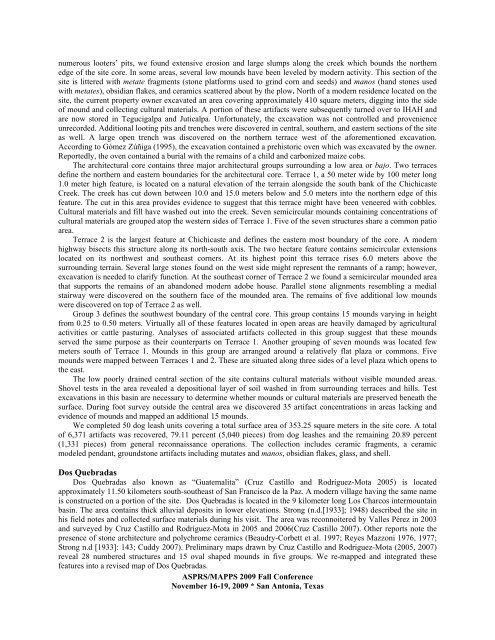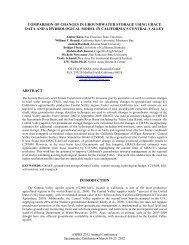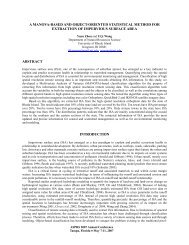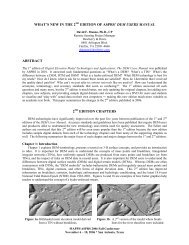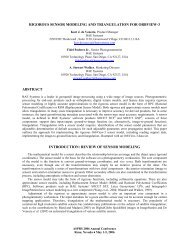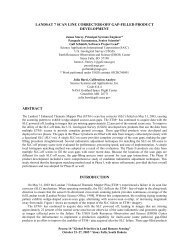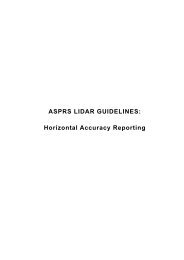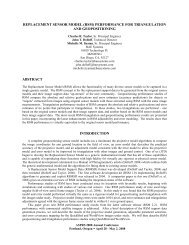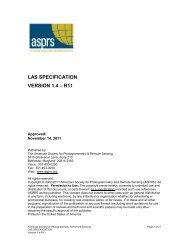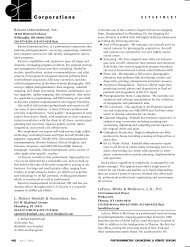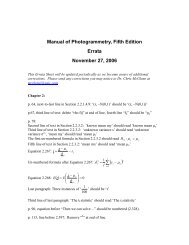archaeological survey of peripheral settlements on the ... - asprs
archaeological survey of peripheral settlements on the ... - asprs
archaeological survey of peripheral settlements on the ... - asprs
Create successful ePaper yourself
Turn your PDF publications into a flip-book with our unique Google optimized e-Paper software.
numerous looters’ pits, we found extensive erosi<strong>on</strong> and large slumps al<strong>on</strong>g <strong>the</strong> creek which bounds <strong>the</strong> nor<strong>the</strong>rn<br />
edge <str<strong>on</strong>g>of</str<strong>on</strong>g> <strong>the</strong> site core. In some areas, several low mounds have been leveled by modern activity. This secti<strong>on</strong> <str<strong>on</strong>g>of</str<strong>on</strong>g> <strong>the</strong><br />
site is littered with metate fragments (st<strong>on</strong>e platforms used to grind corn and seeds) and manos (hand st<strong>on</strong>es used<br />
with metates), obsidian flakes, and ceramics scattered about by <strong>the</strong> plow. North <str<strong>on</strong>g>of</str<strong>on</strong>g> a modern residence located <strong>on</strong> <strong>the</strong><br />
site, <strong>the</strong> current property owner excavated an area covering approximately 410 square meters, digging into <strong>the</strong> side<br />
<str<strong>on</strong>g>of</str<strong>on</strong>g> mound and collecting cultural materials. A porti<strong>on</strong> <str<strong>on</strong>g>of</str<strong>on</strong>g> <strong>the</strong>se artifacts were subsequently turned over to IHAH and<br />
are now stored in Tegucigalpa and Juticalpa. Unfortunately, <strong>the</strong> excavati<strong>on</strong> was not c<strong>on</strong>trolled and provenience<br />
unrecorded. Additi<strong>on</strong>al looting pits and trenches were discovered in central, sou<strong>the</strong>rn, and eastern secti<strong>on</strong>s <str<strong>on</strong>g>of</str<strong>on</strong>g> <strong>the</strong> site<br />
as well. A large open trench was discovered <strong>on</strong> <strong>the</strong> nor<strong>the</strong>rn terrace west <str<strong>on</strong>g>of</str<strong>on</strong>g> <strong>the</strong> aforementi<strong>on</strong>ed excavati<strong>on</strong>.<br />
According to Gómez Zúñiga (1995), <strong>the</strong> excavati<strong>on</strong> c<strong>on</strong>tained a prehistoric oven which was excavated by <strong>the</strong> owner.<br />
Reportedly, <strong>the</strong> oven c<strong>on</strong>tained a burial with <strong>the</strong> remains <str<strong>on</strong>g>of</str<strong>on</strong>g> a child and carb<strong>on</strong>ized maize cobs.<br />
The architectural core c<strong>on</strong>tains three major architectural groups surrounding a low area or bajo. Two terraces<br />
define <strong>the</strong> nor<strong>the</strong>rn and eastern boundaries for <strong>the</strong> architectural core. Terrace 1, a 50 meter wide by 100 meter l<strong>on</strong>g<br />
1.0 meter high feature, is located <strong>on</strong> a natural elevati<strong>on</strong> <str<strong>on</strong>g>of</str<strong>on</strong>g> <strong>the</strong> terrain al<strong>on</strong>gside <strong>the</strong> south bank <str<strong>on</strong>g>of</str<strong>on</strong>g> <strong>the</strong> Chichicaste<br />
Creek. The creek has cut down between 10.0 and 15.0 meters below and 5.0 meters into <strong>the</strong> nor<strong>the</strong>rn edge <str<strong>on</strong>g>of</str<strong>on</strong>g> this<br />
feature. The cut in this area provides evidence to suggest that this terrace might have been veneered with cobbles.<br />
Cultural materials and fill have washed out into <strong>the</strong> creek. Seven semicircular mounds c<strong>on</strong>taining c<strong>on</strong>centrati<strong>on</strong>s <str<strong>on</strong>g>of</str<strong>on</strong>g><br />
cultural materials are grouped atop <strong>the</strong> western sides <str<strong>on</strong>g>of</str<strong>on</strong>g> Terrace 1. Five <str<strong>on</strong>g>of</str<strong>on</strong>g> <strong>the</strong> seven structures share a comm<strong>on</strong> patio<br />
area.<br />
Terrace 2 is <strong>the</strong> largest feature at Chichicaste and defines <strong>the</strong> eastern most boundary <str<strong>on</strong>g>of</str<strong>on</strong>g> <strong>the</strong> core. A modern<br />
highway bisects this structure al<strong>on</strong>g its north-south axis. The two hectare feature c<strong>on</strong>tains semicircular extensi<strong>on</strong>s<br />
located <strong>on</strong> its northwest and sou<strong>the</strong>ast corners. At its highest point this terrace rises 6.0 meters above <strong>the</strong><br />
surrounding terrain. Several large st<strong>on</strong>es found <strong>on</strong> <strong>the</strong> west side might represent <strong>the</strong> remnants <str<strong>on</strong>g>of</str<strong>on</strong>g> a ramp; however,<br />
excavati<strong>on</strong> is needed to clarify functi<strong>on</strong>. At <strong>the</strong> sou<strong>the</strong>ast corner <str<strong>on</strong>g>of</str<strong>on</strong>g> Terrace 2 we found a semicircular mounded area<br />
that supports <strong>the</strong> remains <str<strong>on</strong>g>of</str<strong>on</strong>g> an aband<strong>on</strong>ed modern adobe house. Parallel st<strong>on</strong>e alignments resembling a medial<br />
stairway were discovered <strong>on</strong> <strong>the</strong> sou<strong>the</strong>rn face <str<strong>on</strong>g>of</str<strong>on</strong>g> <strong>the</strong> mounded area. The remains <str<strong>on</strong>g>of</str<strong>on</strong>g> five additi<strong>on</strong>al low mounds<br />
were discovered <strong>on</strong> top <str<strong>on</strong>g>of</str<strong>on</strong>g> Terrace 2 as well.<br />
Group 3 defines <strong>the</strong> southwest boundary <str<strong>on</strong>g>of</str<strong>on</strong>g> <strong>the</strong> central core. This group c<strong>on</strong>tains 15 mounds varying in height<br />
from 0.25 to 0.50 meters. Virtually all <str<strong>on</strong>g>of</str<strong>on</strong>g> <strong>the</strong>se features located in open areas are heavily damaged by agricultural<br />
activities or cattle pasturing. Analyses <str<strong>on</strong>g>of</str<strong>on</strong>g> associated artifacts collected in this group suggest that <strong>the</strong>se mounds<br />
served <strong>the</strong> same purpose as <strong>the</strong>ir counterparts <strong>on</strong> Terrace 1. Ano<strong>the</strong>r grouping <str<strong>on</strong>g>of</str<strong>on</strong>g> seven mounds was located few<br />
meters south <str<strong>on</strong>g>of</str<strong>on</strong>g> Terrace 1. Mounds in this group are arranged around a relatively flat plaza or comm<strong>on</strong>s. Five<br />
mounds were mapped between Terraces 1 and 2. These are situated al<strong>on</strong>g three sides <str<strong>on</strong>g>of</str<strong>on</strong>g> a level plaza which opens to<br />
<strong>the</strong> east.<br />
The low poorly drained central secti<strong>on</strong> <str<strong>on</strong>g>of</str<strong>on</strong>g> <strong>the</strong> site c<strong>on</strong>tains cultural materials without visible mounded areas.<br />
Shovel tests in <strong>the</strong> area revealed a depositi<strong>on</strong>al layer <str<strong>on</strong>g>of</str<strong>on</strong>g> soil washed in from surrounding terraces and hills. Test<br />
excavati<strong>on</strong>s in this basin are necessary to determine whe<strong>the</strong>r mounds or cultural materials are preserved beneath <strong>the</strong><br />
surface. During foot <str<strong>on</strong>g>survey</str<strong>on</strong>g> outside <strong>the</strong> central area we discovered 35 artifact c<strong>on</strong>centrati<strong>on</strong>s in areas lacking and<br />
evidence <str<strong>on</strong>g>of</str<strong>on</strong>g> mounds and mapped an additi<strong>on</strong>al 15 mounds.<br />
We completed 50 dog leash units covering a total surface area <str<strong>on</strong>g>of</str<strong>on</strong>g> 353.25 square meters in <strong>the</strong> site core. A total<br />
<str<strong>on</strong>g>of</str<strong>on</strong>g> 6,371 artifacts was recovered, 79.11 percent (5,040 pieces) from dog leashes and <strong>the</strong> remaining 20.89 percent<br />
(1,331 pieces) from general rec<strong>on</strong>naissance operati<strong>on</strong>s. The collecti<strong>on</strong> includes ceramic fragments, a ceramic<br />
modeled pendant, groundst<strong>on</strong>e artifacts including mutates and manos, obsidian flakes, glass, and shell.<br />
Dos Quebradas<br />
Dos Quebradas also known as “Guatemalita” (Cruz Castillo and Rodríguez-Mota 2005) is located<br />
approximately 11.50 kilometers south-sou<strong>the</strong>ast <str<strong>on</strong>g>of</str<strong>on</strong>g> San Francisco de la Paz. A modern village having <strong>the</strong> same name<br />
is c<strong>on</strong>structed <strong>on</strong> a porti<strong>on</strong> <str<strong>on</strong>g>of</str<strong>on</strong>g> <strong>the</strong> site. Dos Quebradas is located in <strong>the</strong> 9 kilometer l<strong>on</strong>g Los Charcos intermountain<br />
basin. The area c<strong>on</strong>tains thick alluvial deposits in lower elevati<strong>on</strong>s. Str<strong>on</strong>g (n.d.[1933]; 1948) described <strong>the</strong> site in<br />
his field notes and collected surface materials during his visit. The area was rec<strong>on</strong>noitered by Valles Pérez in 2003<br />
and <str<strong>on</strong>g>survey</str<strong>on</strong>g>ed by Cruz Castillo and Rodríguez-Mota in 2005 and 2006(Cruz Castillo 2007). O<strong>the</strong>r reports note <strong>the</strong><br />
presence <str<strong>on</strong>g>of</str<strong>on</strong>g> st<strong>on</strong>e architecture and polychrome ceramics (Beaudry-Corbett et al. 1997; Reyes Mazz<strong>on</strong>i 1976, 1977;<br />
Str<strong>on</strong>g n.d [1933]: 143; Cuddy 2007). Preliminary maps drawn by Cruz Castillo and Rodriguez-Mota (2005, 2007)<br />
reveal 28 numbered structures and 15 oval shaped mounds in five groups. We re-mapped and integrated <strong>the</strong>se<br />
features into a revised map <str<strong>on</strong>g>of</str<strong>on</strong>g> Dos Quebradas.<br />
ASPRS/MAPPS 2009 Fall C<strong>on</strong>ference<br />
November 16-19, 2009 * San Ant<strong>on</strong>ia, Texas


